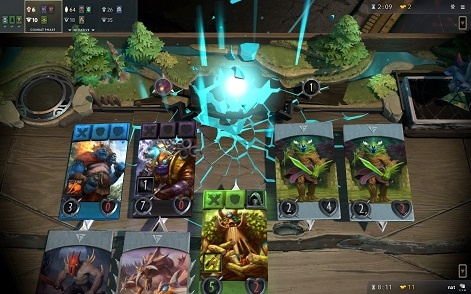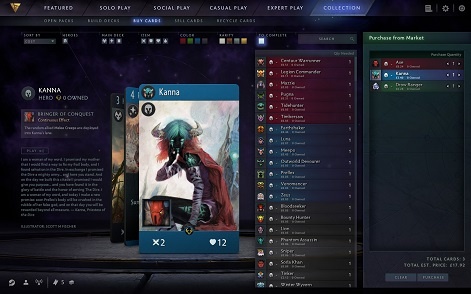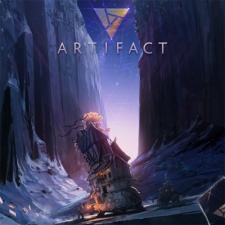Valve’s first new game in over five years has been met with mixed reception.
A collaboration with Magic: The Gathering creator Richard Garfield, Artifact is a collectible card game take on the company’s highly-acclaimed MOBA DOTA 2. Announced during that game's esports world championship tournament The International 2017, the initially-mocked spinoff launched to acclaim as an intelligent translation of the MOBA and a strong card game in its own right.
But Artifact has struck a nerve with fans over its monetisation, leading to an unexpected “mixed” review summary on Steam for the developer’s first game in years. There's been an 81 per cent decline in active players since launch, which seems to show players perhaps waiting to see how the game’s rocky start pans out.
Artifact may not be the most egregiously-monetised game out there. It’s been pointed out by many that a competitive deck in Valve’s card game may cost roughly $300 right now - significantly less than one in Hearthstone or Magic: The Gathering.
So why are players finding it so shocking? We've analysed the game ourselves and kept an eye on the surrounding conversation to try and come up with some answers.
Pay to win to win
For starters, unlike its contemporaries, Artifact isn’t a free-to-play release. Other card games sell card packs, while Hearthstone’s single-player adventures feature similar paywalls to Artifact’s Event Tickets. In a free game, those systems feel like concessions. Anyone can pick up and try the game at no cost and that comes with an understanding that occasionally you’ll be asked to shill out a little.
Artifact, meanwhile, costs $19.99. For that, you get 10 card packs (priced $1.99 each), with 12 standard cards and one rare card in each. Luck depending, players may have the tools for a decent deck out of the box, but most are going to need more cards, which can’t be earned through grinding out games.
It can often feel like you need a spreadsheet to describe the ways players can buy cards in Artifact. It’s complicated enough that Valve itself issued an FAQ to explain many of its systems, but we'll take a crack at it.

There are straight up pack purchases, of course. But players can also take part in Event games, which are as close as Artifact comes to competitive play. Win five in a row and win two card packs - but first, pay up for Event Tickets at $4.95 for five tickets.
Keeper Draft events, where players draft a deck from packs to compete, cost two tickets and the price of five packs at $12 total. Of course, players can always compete in Casual play rather than Event.
There are no ladders in Artifact right now and Tournament Play has only recently been added to the game. Without any tangible progression system, the only rewards come from a chance to win Packs in Event Play.
Setting up shop
Artifact is tied to Steam in a deeper way than just sitting on its shelves, however. Steam has been selling trading cards for years now and Artifact comes with full Steam Marketplace support. Buy and sell cards straight-up and ignore the random pack system entirely. As Waypoint claimed in its review, Artifact is as much a market as it is a DOTA 2 spin-off card game.

Valve takes a cut of all transactions made on the marketplace. As long as players are buying and selling cards between each other, Valve is making bank. The developer has set itself up to let the market do its thing and make a pretty penny on top of it.
And because that market is run by other players, some of the pricing can become egregious. In the weeks since launch, costs have evened out, but when hero cards - unique characters who determine what can and cannot be played - are in demand, they’re really in demand. Axe, a red hero, peaked at $38.73 early on, almost twice the cost of the base game.
We often found cards we enjoyed playing in blind draft modes or through pre-built limited-time Call To Arms decks were selling for dollars.
Meanwhile, weak cards sell for a pittance, worth little more than fuel to recycle into Event Tickets at 20-cards apiece. Price-spiking evens out as more packs are opened, but it’s a pattern likely to repeat itself whenever new cards are added to the game.
Of its era
Perhaps Artifact’s problem is that its game is eclipsed by the economy surrounding it. As a game, it’s a fantastic exploration of how to take DOTA 2’s MOBA mastery and translate it into a card game.
But to play Artifact is to be made intrinsically aware of the marketplace it’s built on and the long-term infrastructure it wants to set up. It wants you to be aware not only of how valuable your deck is in-game but also of how much it could net you on the Steam Marketplace.
It’s a game that could only have been made by the Valve of 2018. Not by the Valve of Half-Life’s tight single-player stories or even extended mastery of Team Fortress 2 and DOTA 2's live game services.
It’s the game developed by a company that has finely-tuned its dominating storefront into a money-making machine and has mastered the ability to extract funds from its userbase. It will be fascinating to see if Valve, in the long-term, can turn round early naysayers on such an economy and build another big hit.













